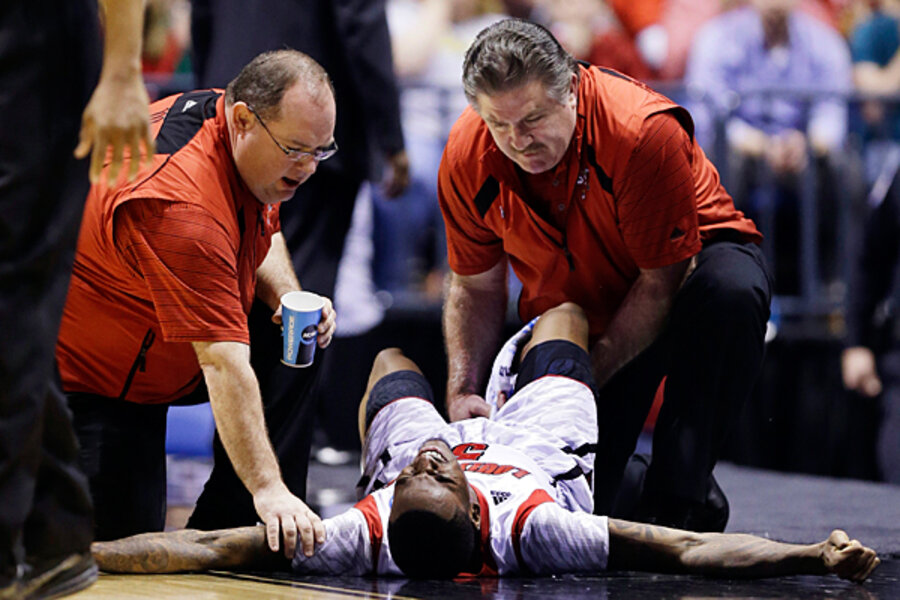CBS broken leg replay: Did the network handle it right?
Loading...
When Louisville basketball player Kevin Ware crumpled to the ground during the first half of his team’s Elite Eight game against Duke Sunday, many viewers hardly saw him fall.
But as play came to a halt, it became clear Ware had suffered an ugly leg break, with bone visible.
That left CBS, the network broadcasting the game, to make a rapid decision about what to do with the graphic scene that had just unfolded.
It’s the kind of choice that falls into a moral gray area for sports broadcasters: Is replaying brutal injury footage exploiting a traumatic situation for shock value? Or is keeping it off the air a paternalistic way of shielding viewers from what’s happening in the arena?
"We did not zoom in on the injury when he was taken off,'' CBS Sports head Sean McManus told the Associated Press just after the game. "We did not try to highlight it. I think we did the right thing.''
Just after Ware fell, CBS showed two quick replays of the injury – and then banished the footage. The network instead focused on the reactions of Ware’s teammates and coaches, and it showed close-ups of his face and upper body. At half time, CBS sportscaster Greg Gumbel said the network wouldn’t show the injury footage again.
As the incident became national news, other media outlets followed suit.
The unedited video was hard to find on national news outlets within 24 hours, when it was still a fresh news story. CNN aired the sequence, but blurred out Ware's leg so the break was not visible. Fox News Channel and MSNBC did not show the video, representatives said.
ABC's "Good Morning America" showed footage, again with the leg blurred. NBC's "Today" show and the CBS morning news program did not show it.
At ESPN, executives set specific guidelines: Producers had discretion to use it on their own programs but they were to only show it once, not air it in slow motion and warn viewers in advance. Through Monday afternoon, spokesman Josh Krulewitz said he did not believe the network had shown it.
Some commentators, however, noted that it wasn’t difficult for CBS to take the “high road” and stop airing the footage because Internet-savvy viewers knew they could find the replay elsewhere if they wanted to see it.
"If people want to go watch the footage for whatever reason, they have a right to do so," Mr. McManus told the AP. "I just didn't think we had any obligation to be the facilitator of putting that footage back on the screen. We documented it, we described it, and we showed it, and I think that was enough."
As debate over how the network handled the injury rippled outward on the Internet, a loose consensus seemed to emerge.
“CBS handled things on the fly about as delicately as anyone could have managed,” wrote Barry Petchesky on Deadspin. “When offering something as discomfiting as the Kevin Ware replay, viewers deserve as much of a choice as possible.”
“[T]he video is news, and despite its warts,... sports news station ESPN should show it,” wrote Connor Simpson on The Atlantic Wire. “They should issue a warning before showing it, and exercise some discretion when calculating the number of [times] it's played in a broadcast.”
As Mr. Petchesky notes, CBS had sports broadcast history as a guide when deciding how to handle the Ware footage.
In 1985, Washington Redskins quarterback Joe Theismann suffered a similarly brutal broken leg during a "Monday Night Football" broadcast. In that incident, ABC also chose to show two replays of the event.
But as Petchesky points out, the network's initial discretion did little to stop the footage from becoming the most replayed sports injury ever.
By Tuesday morning, copies of CBS’s footage of the Ware injury had more than 1 million views on YouTube.








